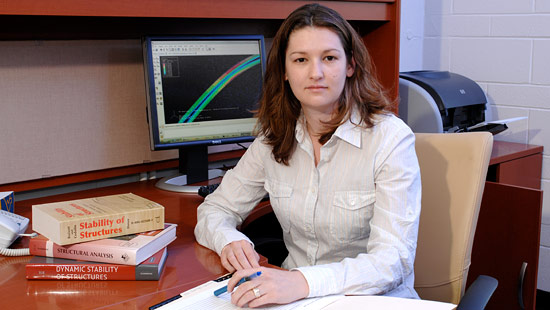
By diane kukichCollege of Health Sciences

An explosion in a Moscow airport on January 24, 2011, was yet another act of terrorism in a world that has seen an increase in public violence over the past decade. The effects of such explosions, whether they occur in crowded city venues or remote battlefields, include structural collapse, debris impact and fire. Additional casualties can result when collapsed structures and accumulated debris block quick evacuation from a site overcome by flames or smoke.
Composite materials may provide a solution to at least some of these blast effects by mitigating collapse and containing debris.
Research led by Jennifer Righman McConnell, assistant professor in UD's Department of Civil and Environmental Engineering, is aimed at designing composite materials to resist the devastating effects of blasts. The work focuses on optimizing the material properties as well as the geometry of blast-resistant composite structures.
"Composite sandwich panels made of glass-fiber-reinforced plastic face sheets and aluminum foam core have excellent energy absorption capabilities under dynamic loading," McConnell says. "One effective approach to providing blast resistance is to design a sacrificial layer surrounding the protected structure and maximize the potential for energy absorption of that sacrificial layer."
Past research has focused on comparing the energy-absorption characteristics of existing composite configurations — for example, glass-reinforced polymer or Kevlar-reinforced polyester. Composites, however, can be tailor-designed from the nano to the macro-level, so McConnell is taking a different approach.
She and her students are starting with a generic base material and changing various material properties one at a time so that they can determine the influence of each one on energy absorption. Once the ideal parameters are known, a material can be tailored to this function.
The design philosophy underlying the work is that progressive collapse of the core structure in the sandwich panels dissipates energy while the face sheets remain relatively intact to avoid secondary damage from debris strikes on humans and structures.
Like the materials making up the sandwich panels, the panels themselves can be tailored to minimize the energy transferred from blast waves to the main structure. McConnell is methodically exploring various geometries of square-celled honeycomb sandwich panels to determine the optimum configuration for absorbing blast energy. Variables include the thicknesses of different structural components and the number of cells.
McConnell's work is supported by a grant from the Army Research Office through the Defense Experimental Program to Stimulate Competitive Research (DEPSCoR). Potential applications include not only military vehicle bodies and temporary military shelters, but also civilian infrastructure such as bridges and building facades. — Diane Kukich